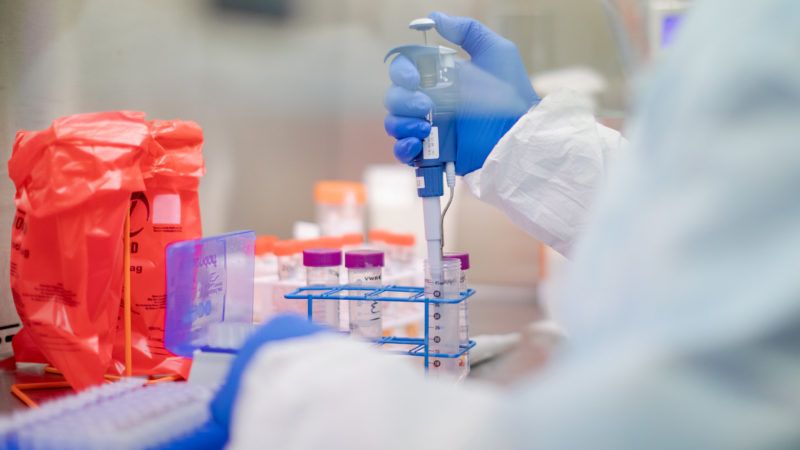What We Should Have Learned From Iceland's Response to COVID-19
Early and wide testing helps curtail the epidemic while casting light on the prevalence and lethality of the virus.

As epidemiologists around the world try to get a handle on COVID-19's actual prevalence and its true case fatality rate (CFR), Iceland seems to be the only country that is doing the sort of testing that is necessary to estimate those crucial variables. As of midnight, Iceland had tested more than 22,000 people for the COVID-19 virus, more than 6 percent of the country's population. Crucially, that number includes seemingly healthy, asymptomatic individuals as well as patients worried that they might have COVID-19.
Those tests, conducted by the National University Hospital of Iceland and the Reykjavík-based biopharmaceutical company deCODE Genetics, have detected 1,364 infections so far. Iceland, which is still in the early stages of its epidemic, has reported just four COVID-19 deaths, making its crude CFR (reported deaths as a share of confirmed cases) at this point 0.3 percent, much lower than the rates indicated by the official numbers from the vast majority of countries. Right now the crude CFR in the United States is 2.6 percent. It is 1.4 percent in Germany, 9.1 percent in France, 9.3 percent in Spain, 9.4 percent in the U.K., and 12.3 percent in Italy.
The epidemic is further along in all of those countries, so we should not make too much of the contrast with Iceland. The death toll in Iceland is bound to rise, and the crude CFR probably will too, as it has in Europe and the United States. But Israel, which had its first confirmed COVID-19 case around the same time as Iceland did and has implemented severe restrictions on visitors coupled with a general lockdown, currently has a crude CFR of 0.5 percent, two-thirds higher than Iceland's. In Greece, which reported its first COVID-19 case two days before Iceland did, the crude CFR is currently 3.8 percent.
As of Tuesday, deCODE Genetics, which ultimately expects to screen at least 50,000 people in Iceland, had tested about 9,000 volunteers from the general population, of whom around 1 percent tested positive. About half of the people who tested positive reported no symptoms, underlining the importance of general testing in estimating the prevalence of infection.
The deCODE sample is self-selected, so it may not be nationally representative. But assuming the sample's infection rate applies to the general population, it means that something like 3,400 Icelanders already have been infected, implying a current CFR (including mild and asymptomatic cases) of around 0.1 percent, which would make COVID-19 in Iceland about as deadly as the seasonal flu. Even assuming that Iceland in a month has as many COVID-19 deaths, as a proportion of its population, as the United States does now, the CFR would still be remarkably low.
If the CFR for COVID-19 in Iceland turns out to be only slightly higher than the CFR for the flu, it would be near the low end of the estimate range that U.S. public health officials consider reasonable. By comparison, projections by the U.S. Centers for Disease Control and Prevention (CDC) imply a CFR of 0.8 percent, while the model used by researchers at Imperial College in London assumes it is 0.9 percent. Today Brendan Murphy, Australia's chief medical officer, said as many as 10 million people may already be infected worldwide—nearly 10 times the official tally. Based on the 58,000 deaths reported so far, that estimate implies a true global CFR of about 0.6 percent.
It would be risky to draw broad conclusions from the data for Iceland, which has a small population (about 340,000) and unusual demographics. Ninety-three percent of Icelanders are ethnically Icelandic, while 3 percent are of Polish origin. The population is also younger than those of many other developed countries, with a median age of 36.5, compared to 45.5 in Italy, 42.7 in Spain, 47.1 in Germany, 40.5 in the U.K., and 38.1 in the United States. That fact is potentially significant, since the elderly are especially susceptible to COVID-19.
Iceland's response to COVID-19—which features aggressive testing, contact tracing, and quarantines of infected people but no general lockdown—is also strikingly different from the response in the United States, where the federal government squandered the opportunity to take a more proactive and targeted approach. Iceland began testing people in early February, weeks before its first confirmed case.
"The only reason that we are doing better is that we were even more vigilant," deCODE founder Kári Stefánsson told CNN. "We took seriously the news of an epidemic starting in China. We didn't shrug our shoulders and say, 'This is not going to be anything remarkable.'"
In the United States, by contrast, a government-engineered testing fiasco left public officials scrambling to prevent hospitals from being overwhelmed by COVID-19 cases, leading to a panoply of business closure and stay-at-home orders. Even now, we have managed to test just 0.4 percent of the population, and those tests have been limited mainly to people with symptoms severe enough to seek treatment. Iceland has tested 16 times as many people as a share of its population, and it has made a deliberate effort to sample people with mild or no symptoms.
Because of the failure to conduct wide testing, we have no idea how many Americans are infected with COVID-19 or what the true CFR in the United States might be. In these circumstances, it is not much of a stretch to lay the blame for the country's ever-worsening, self-inflicted economic crisis at the feet of the CDC and the Food and Drug Administration, which obstructed access to COVID-19 tests through a combination of shortsightedness, ineptitude, and bureaucratic intransigence.


Show Comments (71)